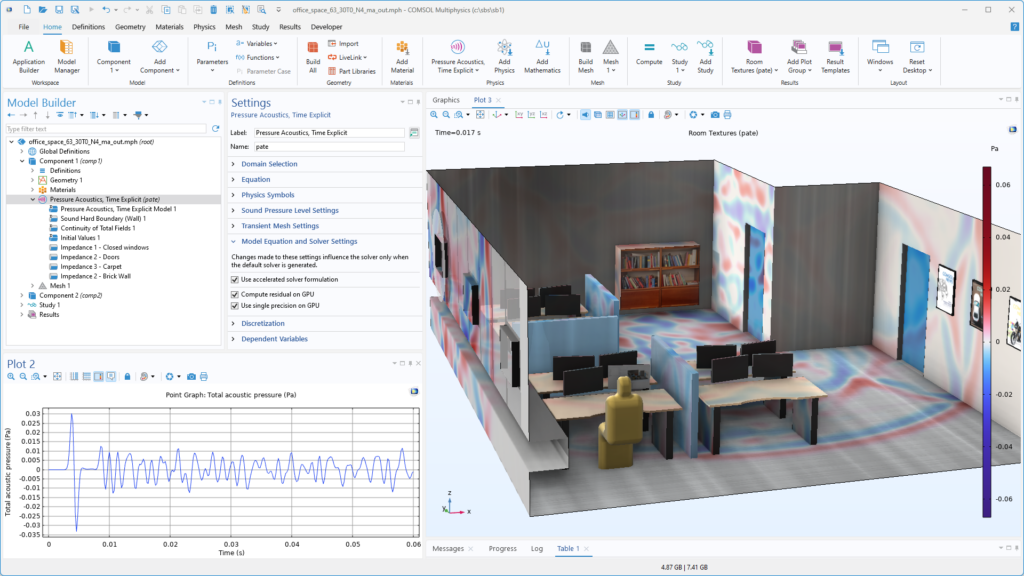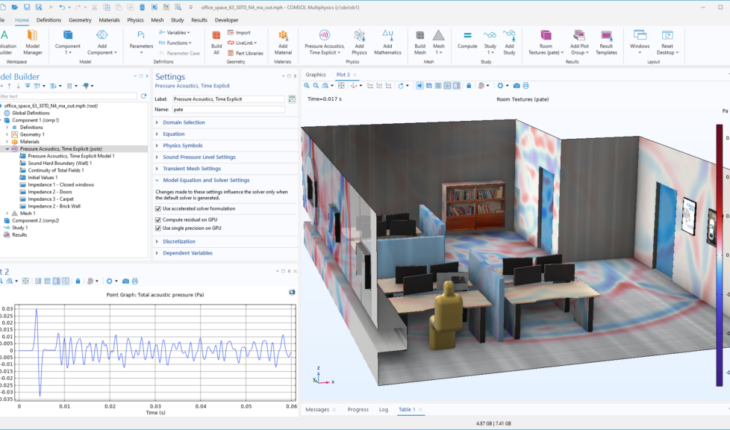Comsol’s Bjorn Sjodin shares his favorite features and how they’ll benefit users of the simulation platform’s latest version.
This month Comsol dropped the latest update to its simulation platform, Comsol Multiphysics version 6.3. With time-saving enhancements and a few long-awaited new features, the update may just be the best present Comsol users get this holiday season (okay, maybe not, but it definitely beats the colander your aunt is planning to regift you).
To learn more about the latest update and why it’s a big deal for Comsol Multiphysics users, Engineering.com sat down with Bjorn Sjodin, senior vice president of product management at Comsol. Sjodin took us through his favorite features of the new release and shared his insight into the evolving simulation landscape.

The following interview has been edited for clarity and brevity.
Engineering.com: What are your favorite features of the new release?
Bjorn Sjodin: The new product is probably my favorite feature, the electric discharge module. It’s an add-on product to Comsol Multiphysics for simulating electric discharges.
For example, say you’re in your car and you get statically charged and you touch some of your control panels, and there’s a little spark that destroys electronics. Or it could be that someone is expanding equipment for next generation power grids for renewable energy and electric vehicles. Lots of new power system equipment is needed, and with that comes safety concerns. The electric discharge model can help in evaluating those new equipment designs for safety, so that people that service that equipment don’t get accidental discharges in their bodies.

How would users simulate that kind of thing prior to this release?
We have some very basic functionality for this in previous versions. You can use electromagnetic simulation to detect where there is risk for electric discharge by very simple means.
But with the electric discharge module, you can do it more efficiently. You can detect where there is risk for electric discharge, but you can now also simulate the actual discharge phenomena themselves for the first time. You couldn’t do that before, because the physics involved is very, very complicated, so it has to be pre-packaged for users to make it easy to use. And that’s what we have done in this new module. And we hide all the complicated physics behind the scenes so that the users get a friendly interface where they can enter their CAD geometries and their material parameters and what have you.
Is the electric discharge module something that users were requesting?
Yes they were. We have had users using our other tools for various discharge and discharge-like phenomena for 20 years, so this is something that people have requested for a long time.
The issue, though, has been with the speed of the computers. We could have done this many years ago, probably, but computers weren’t strong enough. Now they are. So now it is reasonable to do these type of simulations, because the phenomena that goes into these are quite complicated. It’s a combination of electromagnetics, fluid flow and chemical reactions that requires a lot of computational power.
Is that generally how you plan your development roadmap, based on user requests and computing power?
Yes, those are certainly elements. How we decide products is kind of complicated. It depends on what are customers asking for? What is technically possible to do? Do we have the people on board that could produce such products? Those are usually the most critical factors. And of course, is there high enough demand?
Any other favorite updates in Multiphysics 6.3?
We have GPU support for the first time in Comsol in two different ways in 6.3. One is that we have GPU support for accelerating acoustic simulations. Transient phenomena in acoustics could be like you have some sound, some noise happening in a room or in a car, for example, and then this new technology makes it possible to see how the acoustic pressure rays are propagating through the room or the car over time. And it could be up to 25 times faster than previous versions without GPU, which is fantastic. That’s like between one and two orders of magnitude faster.

We also have GPU support for another application, and that is to train the neural network models that people have started to use. Essentially, you build a final element simulation first, and then you train one of these neural network models to replace the final element simulation. So it’s not a replacement for the simulation. You have to do the simulation first, but then you train your neural network, and you use that as a fast replacement for the finite element simulation.
That gives you instantaneous results if you need that for some reason. Maybe you’re doing a system simulation. Maybe you are creating one of our simulation apps and you want your users to get instantaneous results. So you then pre-compile these simulations by using neural networks. That now has GPU support, so you can train these neural network much faster than previous versions—20, 25 times faster than before.
Is that a typical speedup or more of a best case scenario?
It’s a typical speed up. In general, it will depend highly on the CAD geometry. Is it a uniform geometry? Is it very elongated? All of those kinds of different modeling aspects will affect the speed. It could vary from case to case. Could be faster, could be slower, depending on the details of the model.
You do have to invest, though, in a dedicated GPU card. You can’t just use any card. If you’re interested in GPU acceleration, you should invest in a high end card. Otherwise you don’t get that dramatic performance boost. We support Nvidia cards.
Do you support AMD graphics cards as well?
We don’t support AMD yet, but we will look into all possibilities for the future, of course.
Is the new electric discharge module also GPU-accelerated?
It’s not running on GPU yet, but we certainly hope to have that running on GPUs in the future. Multiphysics simulations have always been difficult to accelerate on GPUs, but new technologies are emerging now that will we think will make this possible more and more moving forward.
If you look at the GPU support that is out there in the simulation world, it’s usually for single physics phenomena, because that’s where it was easy. It’s true for anything simulation. You start with one physics, and then when that is mature enough, you go to two, and then three and four and so on. So it’s the same thing with GPU, which is a relatively new technology.
Can you tell me about the automated geometry preparation tools in Multiphysics 6.3? Are they based on AI?
That is based on what we call heuristic rules. I wouldn’t call it AI. That is more based on the experience we have built up over the years on what type of simplifications customers would like to have with CAD models to make their meshing easier, to make their simulations faster.
So that was possible before, but with manual means. Now, we have made it an option to let the computer do all the work for you, all the simplifications for you, automatically. And this is the first time we have done that. It’s very exciting and extremely useful for all of our large industrial customers who have complicated CAD geometries.
How much time could users save with these automated tools, as opposed to the manual way?
Best case scenario, you could go from hours to minutes.
The final new feature I want to ask you about is the chatbot. Is that some sort of ChatGPT-like model?
Yes,exactly. It’s not even like ChatGPT, it is ChatGPT. We connect to ChatGPT, so we don’t ship a chatbot with Comsol Multiphysics.
The idea here is that the user will connect to their own preferred chatbot. And in this first version of this, we allow connections with ChatGPT, but we hope to connect to other chatbots in the future as well. So the user will provide their subscription information in Comsol, and that will establish a link to ChatGPT. And we then prime the questions that you ask with context so ChatGPT understands that this question is coming from a Comsol Multphysics user from the Comsol Multiphysics user interface. So it knows what to send back. So what we have implemented is establishing the communication channel and the context by priming it with some prompts, basically.
Interested in more insight from Bjorn Sjodin on the latest trends in simulation? Stay tuned for a bonus Q&A (sign up for Engineering.com’s Simulation newsletter to make sure you don’t miss it).





